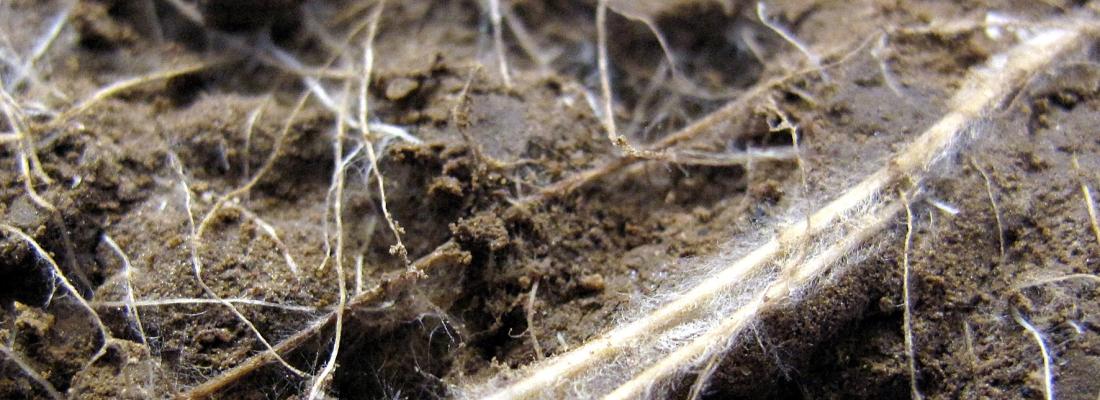Agroecology Reading time 3 min
Phenotyping root growth using rhizotrons
Published on 17 October 2017

Description of the rhizotron system
Working in collaboration with the Burgundian firm Inoviaflow, INRA has developed rhizotrons (Rhizotubes™) that enable continuous phenotyping of a large number of plants during their growth by means of an automated imaging cabin (RhizoCab™), developed with InoviaFlow and the Marseilles firm Shakti. Thus, at INRA’s 4PMI platform (Phenotyping Platform for Plant and Plant Micro-organism Interactions) in Dijon, more than 1200 RhizoTubes, each containing one to six plants can be characterised automatically every day for a large number of traits in an environment that is perfectly controlled at the climatic and microbiological levels. This patented RhizoTube system (and the RhizoCab) thus enable the in situ observation of root systems and interactions between the plants and soil pathogenic or mutualist micro-organisms. Very little studied hitherto because of their difficult access, these interactions can now be observed using these new systems. These interactions constitute a major determinant for the adaptation of plants to the environment and cropping systems. For example, the RhizoTube and RhizoCab suite make it possible to visualise both the development and growth of a root system and how they are modulated in response to abiotic environmental variations (e.g. availability of nutrients or water, enrichment in atmospheric carbon dioxide, etc.) or biotic changes (interactions with soil micro-organisms, notably of a symbiotic nature). The system has now been tested successfully on some twenty species (wheat, pea, maize, vine, tomato, weeds, sunflower, etc.) subjected to different environmental conditions (water constraints, contrasted nitrogen nutrition, etc.).
Rhizotrons to study traits of agronomic interest and test the effects of different molecules on root development
These systems enable identification and characterisation of the genetic determinants implicated in key traits that can improve the response of cultivated plants to environmental stresses, and how they interact with micro-organisms in the rhizosphere. Such a system is essential if we are to (i) improve quantitative or association genetics approaches (based on large populations of plants) relative to root characteristics, (ii) enable more accurate phenotyping of the responses of different genotypes to environmental constraints, and (iii) characterise the interactions between micro-organisms in the rhizosphere and root systems. Rhizotrons will therefore enhance research on the genetic determinants involved in agronomic traits of interest for breeding programmes. Furthermore, the RhizoTubes can also be used to test different molecules in terms of plant nutrition, biocontrol or biostimulation, and evaluate their impacts on root growth and development.
Perspectives for the future offered by the rhizotron technology
The Rhizotubes and RhizoCabs, as well as systems developed in parallel for high-throughput potting and the assembly and disassembly of RhizoTubes, are now being distributed by three companies: QUBIT (Kingston, Ontario, Canada), Viewpoint (France) and Phenotrait (Shanghai, China). New RhizoTubes are now being developed with companies as a function of their specific needs, and particularly rhizotrons coupled with hydroponic systems.
These results were obtained by the Joint Research Unit for Agroecology, one of the fourteen members of the Plant2Pro Carnot Institute.
Christophe Salon, INRA Research Director, has just received the third FIEEC prize for this innovation, which was awarded during the Carnot Institute meeting on 19 October 2017.
Publication:
Jeudy, C., Adrian, M., Baussard, C., Bernard, C., Bernaud, E., Bourion, V., Busset, H., Cabrera Bosquet, L., Cointault, F., Han, S., Lamboeuf, M., Moreau, D., Pivato, B., Prudent, M., Trouvelot, S., Truong, H. N., Vernoud, V., Voisin, A.-S., Wipf, D., Salon, C. 2016. RhizoTubes as a new tool for high throughput imaging of plant root development and architecture: test, comparison with pot grown plants and validation. Plant Methods, 12. DOI: 10.1186/s13007-016-0131-9
Joint INRA- Innoviaflow patent filed: EP 2679088 A1:
Rhizotron and uses thereof:
The rhizotron (10) has an inner wall (12) coaxial with an external wall (13) and defining a root propagation space (11) intended to receive a substrate along with the external wall. An upper part of a housing (45) supports a seed independently from presence of the substrate within the space. The housing is in communication with the space. A supply system supplies liquid e.g. water or nutritive solution, to the space. The space comprises a set of zones including a liquid storage zone and a root propagation zone. The inner wall consists of a material chosen from a polymeric natural or synthetic material. The internal wall consists of a material of metal. An independent claim is also included for a method for determining a phenotypic characteristic of roots of plants
